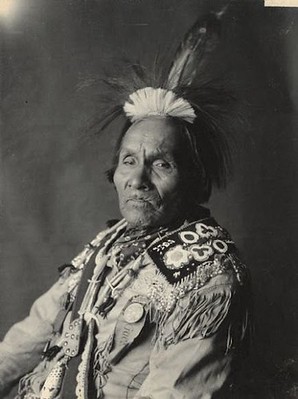
PREV ARTICLE
NEXT ARTICLE
FULL ISSUE
PREV FULL ISSUE
NOTES ON WASHINGTON OVAL PEACE MEDALSDave Fegley submitted these notes on Washington Oval Peace medals. Thanks! -Editor I recently received an email regarding three George Washington Oval Peace medals coming up for auction including a 1795 dated medal that was given to Cayuga chief "Fish Carrier", a 1793 dated medal attested to Joseph Loring and a 1792 medal of an "unknown" engraver. 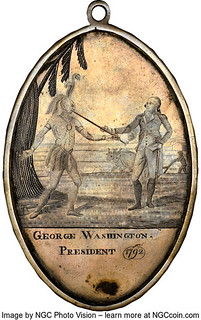
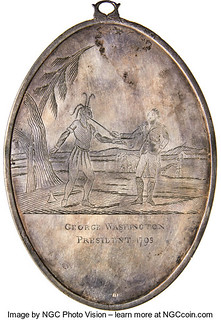
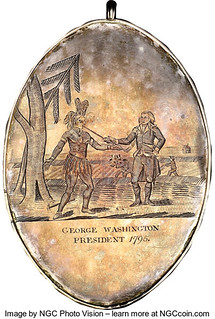
Lots 3964, 3965, 3966 Upon viewing the medals I was surprised to find that they had actually been authenticated by the NGC. It was my understanding that they had never authenticated this type of medal. I was also surprised to find the description of the 1795 medal actually claimed it was the medal given to "Fish Carrier" by George Washington. I thought this was curious as I had done considerable research regarding this (and other) medals of this timeframe and was sure that the "Fish Carrier" medal was a 1792 that was presented by Washington in a group of six that included "Red Jacket", "Cornplanter", Governor "Black Snake" and two others according to General Strong in NY Senate testimony in 1899. I revisited my research starting with the "Cayuga Land Claim Case VS the State of NY" of which was referenced in the description of the 1795 medal in question with a quotation of the states attorney referring to the medal presented as evidence by Isaac Davis as being a "pretentious affair". This is a somewhat misleading quote used in the dissertation. A better choice may have been all of the witness testimony regarding the 1792 medal of "Fish Carrier". 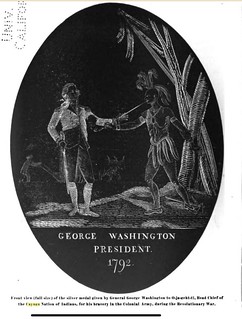

These pictures are included in the same NY State Senate document after page 26 If you read the entire transcript of NY Senate document of January 10, 1900 you will find the "pretentious affair" statement is in regards to the medal being relevant as evidence in the "Cayuga Land Claim" case. Not the authenticity or provenance of the 1792 medal itself. The Cayuga response is that it shows they are the original band and original continual lineage of Chiefs and relics that include the 1795 New York treaty that is written on deerskin. Another reference to the medal of "Fish Carrier" is found in an 1885 Canadian publication "The Dominion Annual Register and Review of 1884" on page 337 in the "Remarkable Occurrences" chapter. It tells of Cayuga Chief Isaac Davis producing the medal presented to "Fish Carrier" by George Washington in 1792 as evidence in a land claim case. It is also referenced in a May 5 1884 New York Times article as a 1792 medal. There is overwhelming evidence that this is not a typo. The medal is mentioned again in a December 8, 1901 Washington Times article along with other relics in the possession of "Fish Carrier" - (referring to William Henry, grandson of medal recipient also called "Fish Carrier"). The medal and 1795 treaty written on deerskin is said to have been in the same family since 1795 with no reference of the date on the medal. This is most likely where the confusion started. It could be easily assumed that the medal was associated with the treaty. The treaty was with the state of New York, not the US Government. A GW medal was not associated. This is all in the same timeframe (1901-1905) that "Fish Carrier" (William Henry) attended the Expo in New York and litigation was ongoing over the land claim. It is reasonable to believe the medal was not catalogued correctly in 1905 and ever since by using "provenance of collection" as authentication instead of modern forensics and research (or the findings and test results have been concealed). Just because a certain collector or a coin cataloguer misrepresented a relic over 100 years ago and it is regurgitated over and over, doesn't make it true. It is understandable to a point in time that research was very difficult and little choice was left but to go with prior sale references provided by the owners. We are way past that time and many tools are available that allows forensic testing of the composition that can identify certain elements that would or would not confirm certain time periods. This would be especially effective with the three medals mentioned as they are all silver plated. It would provide many points of study that includes the plating method, the underlying copper/silver/etc alloy and the very surfacing of the underplate itself that includes makers marks and esoterica that as an art form can identify the individual artisans. (A recent E-Sylum article on the 1792 Silver Disme project discusses using super brilliant Xrays in an attempt to decipher the same type of esoterica included in coin dies as an anti counterfeiting method). The alloy of the silver plated sheet is designed to defy specific gravity tests. This was not an uncommon practice of silversmiths of the period in their construction of silver plated wares. There is a very similar 1795 medal that is a known circa 1884 "reproduction" by the National Numismatic Collection and is pictured in "Coin World" magazine of April 2013. I am not saying the 1795 in question is not an authentic GW medal, but considering the misconception in regards to being "Fish Carriers", a simple XRF test of the weld attaching the ring to the rim for the presence of cadmium specifically should be performed to forensically confirm period construction. Some of the authentic medals I have been able to study firsthand have had repairs to the suspension ring and Cadmium is present in the repair weld, but a patina and remnants of original weld can be found underneath. An interesting story came to light in the senate testimony that claimed the rim was damaged on the "Fish Carrier" medal and Joseph Monture had made rings from the original rim. The book "Peace Medals, Negotiating Power In Early America" is heavily referenced as George Fuld and many other leading experts were involved in the publication of the book. In regards to the 1792 small size medal (by unknown engraver) the dissertation lists eight known small size 1792 medals documented by Fuld. This list excluded the Woolaroc 1792 medal that is on the cover of the Gilcrease book and included in a special addendum. That medal in particular has a solid provenance being excavated from the "Fallen Timbers" battlefield in 1933 and a short lineage of ownership. It would be a good candidate for forensic study. This particular small size 1792 is identified as number 3 on the list of eight. It also speculates that it may be the medal mentioned by Beldon as possibly being the one owned by a New York resident. Myself and a few others would disagree as we have credible reason to believe that we know the whereabouts of that particular 1792 medal and it is still in private hands. Regardless the 1792 medal offered in the sale by Heritage I consider to be very beautifully engraved and in the "style" of Richardson. Not only in his style, but of his hand. He included a few easily discerned "makers marks" in the engraving. One of which is located on the Indians left arm just above the armband. You will find more of the same JR initials scattered about the entire work. These medals like other types of engraved works were seldom performed by a single engraver, but by a team of engravers. Considering at this time the fledgling US Mint was charged with the creation of these medals. The list of suspect engravers should start there and include the list of assayers that were approved to regulate and correct our early coinage. Daniel Van Voorhis and Peter Getz should be considered as most likely contributors to the creation of these early medals. Beginning with the Mint engravers at this time it is impossible to exclude Joseph Wright who was the first engraver of the US Mint and responsible for the design of some of our earliest coins. It is very possible some of these 1792 medals are the earliest known US Mint relics extant. Predating any coins yet to be produced. Joseph (Lovell) Wright and his mother Patience Lovell Wright were well acquainted with Benjamin Franklin and even stayed with him in Paris during the time Franklin was associated with the "Lodge of the Nine Sisters" and had even been elected "Master of the Lodge" in 1779 and 1780. (This lodge was known to include many Jacobite exiles and a source of funding for both the French and American Revolutions). Joseph Wright was associated to the Nine Sisters Lodge through Franklin and was the first American to attend the Royal Academy.
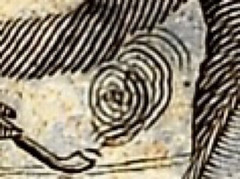
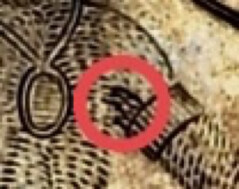

Our research has led us to believe that some 1792 and a few 1793 GW medals with the date encircled with the extended leg of the number 9 is a veiled reference to the "Lodge of the Nine Sisters" as well as the puffs of smoke from the pipe that often form a number 9. This medal in particular has a supposed comma after WASHINGTON,. This could be considered another number 9 reference. Notice the JW and JR in the puff of smoke just above the pipe. (Pictures slightly enhanced) These are a few subtleties built into the engraving that lead us to believe that Joseph Wright was directly involved in the creation of particular medals that include these or other number 9 references. Also note flaking silver plating above the date. The practice of encircling the date disappeared after 1793. Joseph Wright died in September of 1793 during the Yellow Fever epidemic in Philadelphia. This is another point to include when considering the plausibility of a group of engravers that includes at least Joseph Richardson and Joseph Wright working together to create a single medal such as this one. This is not only among the first creations of the US Mint, but a priceless piece of history. The condition of the medal would allow for a good forensic study as the silver plating has flaked at several places (I guess this is the "Hints of gold" in the description) that would allow for a better XRF test result of the underlying alloy. The supposed "splash of deep steel" on the obverse is cuprite from the copper alloy that is bleeding through the silver plating. Spots like this are usually associated with an esoteric etching on the underplate that both provides a shaded image (the slight texture captures light a bit differently than the surrounding surface) as well as an anchor for the plating. This same practice can be found and I have observed the same type of surfacing on silver plated spoons that came from the Richardson shop during this same period. I strongly urge the next owner to contribute to the much needed furtherment of study of this class of medals and submit it to a modern forensic metallurgical study. The information is invaluable and necessary for the advancement of history as well as the creation of a type of scientific norm that can be used to evaluate other like relics. The 1793 JL stamped medal in this sale exhibits some of the same type of esoteric etchings on the underplate as on the 1792 medal, but definitely a different hand on this one. If you notice how the medal appears at places to be corroded and plated over. It is likely that the etching process used may have gone a bit too far prior to plating. If you look very closely at the supposed scratches from cleaning you will find that some are actually under the silver plating as part of the surfacing of the alloy. You may also notice that they are not random or consistent with a polishing motion. They are somewhat different than the surfacing done on the Richardson medals mentioned above. Heritage Auction supplied very good photos that allow us to study some of these finer points. Note that the date is not circled and the puff of smoke is not in the shape of a number 9. You will also find there is a lack of Joseph Richardsons initials included in the engraving. The JL punch is authenticated to Joseph Loring on the NGC encapsulation. The Gilcrease Museum describes the punches on known authentic medals like this; "At least three different silversmiths actually created the medals as three different hallmarks are known. One hallmark reads as "JR" or "IR" and is attributed to Joseph Richardson, Jr. of Philadelphia. A second hallmark, "JL" is either silversmith Joseph Loring of Boston or John Lynch of Baltimore. A third hallmark was identified in 2011 on a 1792 medal at the Woolaroc Museum in Bartlesville, OK. It is marked "JW" which is attributed to silversmith Joseph Wyatt of Philadelphia." (The Joseph Wyatt attestment has since been debunked) It seems strange that it wasn't considered until recently that the engraving or creation of that particular medal was performed by Joseph Wright, the engraver for the mint at the time. Wyatt was not in America until 1793 and it doesn't take much common sense to realize that it is the punch of Joseph Wright himself. Recent analysis of a JW stamped medal revealed it to be JJLW - Joseph Lovell Wright Junior
Joseph Lownes as suggested by Beldon would seem the most logical as he was the only one of the five that was established in Philadelphia at the time as well as the only one that I could find reference to as being associated with the mint through payment and bullion deposit records. Apparently the NGC has found new evidence that positively identifies Loring as the maker and speculation may be irrelevant. It's all these mystery's and associated research that uncover many historically significant facts and interesting stories along the way that enhances the joy of collecting. These early medals should be considered among the most historically significant US Mint relics that are obtainable. ABOVE: WILLIAM HENRY CIRCA 1901- GRANDSON OF "FISH CARRIER" Here are a few links that will provide some interesting reading and a basis for your own research into my findings and observances.
To read the earlier E-Sylum articles, see:

Wayne Homren, Editor The Numismatic Bibliomania Society is a non-profit organization promoting numismatic literature. See our web site at coinbooks.org. To submit items for publication in The E-Sylum, write to the Editor at this address: whomren@gmail.com To subscribe go to: https://my.binhost.com/lists/listinfo/esylum All Rights Reserved. NBS Home Page Contact the NBS webmaster 
|
